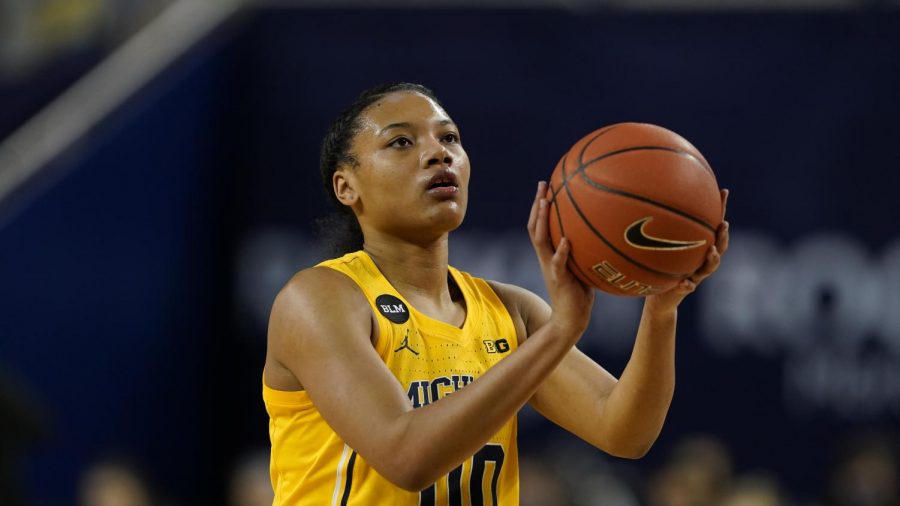Future Of Sports Up In The Air
Naz Hillmon of Michigan prepares to shoot during a Feb. 16 NCAA Game.
October 15, 2021
Flipping through the channels, it’s clear something’s amiss.
CNN, BBC and NBC’s sports networks, once the liveliest on TV, are now filled with the voices of bored announcers and shots of empty bleachers.
American sports as we know them are dying. And it’s happening because men are getting healthier.
In the youth of sports, American men were at an emotional low:
Since early in the 20th century, sports, tailored to be convenient for average men, offered an outlet for community, comradery and emotional connection to isolated guys.
This paid off so greatly because of the long-term effect of societal pressure on the mental state of the male-dominated body of fans.
These societal constraints are focused largely on breadwinning and stoicism, and resulted in widespread depression, emotional disconnection, and unhealthy individualism within many communities.
According to a study by Movember, an organization dedicated to male health, 58% of men believe society expects them to be strong and 34% fear that discussing mental health could lose them their jobs.
Yet these issues, which facilitated sports’ popularity, are quickly fading from the male populace.
“…gender norms are changing—(there’s) an increase in stay-at-home dads, men reporting a desire to spend more time with their families, and dual household incomes (are) now the norm…” Forbes’ Bernie Wong said.
Alongside the advent of the 21st century, the environment of masculinity is changing. More men are coming to terms with their emotions and the need for sports, an imperfect outlet for emotion, is faltering.
Viewership of the NBA playoffs finals this year fell 50% just from last season, according to the Washington Post, and general viewership for all championships and events is trending low, according to Forbes.
This slump might have to do with the unhealthy machismo taught to incoming players, which alters how many view sports as a whole.
“It teaches boys to suppress vulnerability, and harness aggression and dominance. Winning is everything. Don’t cry like a girl, don’t throw like a girl, and don’t run like a girl…” parenthood expert Elissa Strauss said in an article from CNN.
Yet, fault in this slow decay doesn’t lie with the changing population. Rather, it’s in sports organizations’ inability to change with their target audience.
Look at women’s sports, the growing subfield has experienced huge recent growth, despite the slow decline of sports as a whole.
“Ratings are up. Female athletes are steadily commanding more attention from fans and marketers. And brands and venture capitalists are pouring money into women’s sports.” Ben Strauss and Molly Hensley-Clancy of the Washington Post said.
The main difference is that the relatively new field offers a lot of inclusivity, which appeals to a wider variety of viewers, and little ingrained hatred. The effect is evident.
If the wider sports world could look to women’s sports for an idea of how to approach the future, the business would have a greater likelihood of rebirth after the timely demise of unhealthy masculinity.
There is a desperate need for growth, inclusion and, frankly, reckoning in the sports world. And if these needs can’t be met there is little hope for the future of America’s favorite pastime.












